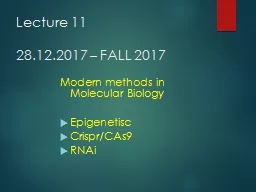

Modern methods in Molecular Biology Epigenetisc Crispr CAs9 RNAi Epigenetic refers to heritable changes in gene expression active versus inactive genes that does not involve changes to the underlying DNA sequence a change in phenotype without a change in genotype ID: 934632
Download Presentation The PPT/PDF document "Lecture 11 28.12.2017 – FALL 2017" is the property of its rightful owner. Permission is granted to download and print the materials on this web site for personal, non-commercial use only, and to display it on your personal computer provided you do not modify the materials and that you retain all copyright notices contained in the materials. By downloading content from our website, you accept the terms of this agreement.
Slide1
Lecture 1128.12.2017 – FALL 2017
Modern methods in Molecular Biology
Epigenetisc
Crispr
/CAs9
RNAi
Slide2Epigenetic refers to heritable changes in gene expression (active versus inactive genes), that does not involve changes to the underlying DNA sequence; a change in phenotype without a change in genotype. Or “
Epigenetics
” refers to covalent modification of DNA, protein, or RNA, resulting in changes to the function and/or regulation of these molecules, without altering their primary DNA sequences.
Epigenetics
Slide3Micro RNA molecules
MicroRNAs
(
miRNAs
) comprise species of short
noncoding
RNA
(18-25
bp
) that
regulate gene expression post-
transcriptionally
.
Recent studies have demonstrated that epigenetic mechanisms, including
DNA
methylation and
histone
modification
, not only regulate the expression of protein-encoding genes, but also
miRNAs
Slide4microRNA processing
Picture taken from:
http://discovermagazine.com/~/media/import/images/0/2/6/micrornadiag.jpg
Slide5Introduction Crispr/Cas9
C
lustered regularly-interspaced
s
hort
p
alindromic
r
epeats (abbreviated as CRISPR, pronounced crisper) are segments of prokaryotic DNA containing short repetitions of base sequences.
CRISPR
is being used as a tool that allows scientists to edit genomes with unprecedented precision, efficiency, and flexibility.
CRISPR
is far better than older techniques for gene splicing and editing
Slide6Slide7https://www.youtube.com/watch?v=4YKFw2KZA5ohttps://
www.youtube.com/watch?time_continue=52&v=0dRT7slyGhs
http://www.genetherapynet.com/gene-editing-tools/crispr-cas9.html
Slide8ApplicationsLike RNAi, CRISPR interference (
CRISPRi
) turns off genes in a reversible fashion by targeting, but not cutting a site. The targeted site is methylated
so the gene is epigenetically modified. This modification inhibits transcription
..
Cas9 was used to carry synthetic transcription factors (protein fragments that turn on genes) that activated specific human genes.
CRISPR
may be used at the
germline
level to create animals where the gene is changed everywhere. CRISPR can also be utilized to create human cellular models of disease.
For
instance, CRISPR was applied to human
pluripotent
stem cells to introduce targeted mutations in genes relevant to two different kidney diseases, polycystic kidney disease and focal segmental
glomerulosclerosis
.
Slide9RNA Interference (RNAi)
supresses the expression of genes,
VIRUS defense system
Previously known as co-
supression
analyzes the gene function for drug delivery
Involve
micro
RNA (miRNA) & small interfering RNA (siRNA)
9
Slide10http://www.rxipharma.com/wp-content/uploads/2017/03/sd-rxRNA-Novel-Technology-Platform-1024x607.png
Slide11Slide12Video linkhttps://www.youtube.com/watch?time_continue=64&v=cK-OGB1_ELE
Slide13Summary
13
RNA
i
≠
CRISPR
/
Cas9
Silencing DNA
Silencing and editing DNA